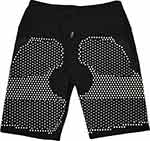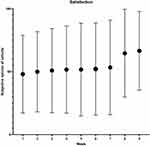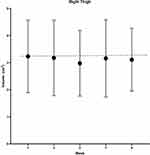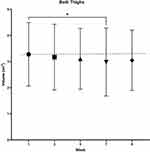Back to Journals » Clinical, Cosmetic and Investigational Dermatology » Volume 16
Participant Reported Improvement in Cellulite by Vari-Pad Apparel and Objective Measurements – A “First Use” Pilot Study
Authors Kiely MJ , Poulsen A, Muschamp SD, Sallis C, Whiteley MS
Received 25 July 2023
Accepted for publication 14 September 2023
Published 20 September 2023 Volume 2023:16 Pages 2573—2583
DOI https://doi.org/10.2147/CCID.S426978
Checked for plagiarism Yes
Review by Single anonymous peer review
Peer reviewer comments 2
Editor who approved publication: Dr Jeffrey Weinberg
Video abstract presented by Mark Whiteley.
Views: 74
Melissa J Kiely, Ashleigh Poulsen, Simon D Muschamp, Chloe Sallis, Mark S Whiteley
Research Department, the Whiteley Clinic, Guildford, Surrey, UK
Correspondence: Mark S Whiteley, The Whiteley Clinic, 1 Stirling House, Stirling Road, Guildford, Surrey, GU2 7RF, UK, Email [email protected]
Background: Cellulite affects 80– 90% of post-pubertal females and, although cosmetic, has proven adverse psychological effects. A new compression garment with patented “vari-pad” technology has been developed, aiming to stimulate lymphatic return from the buttocks and thighs. The primary aim of this small pilot study was to assess participant satisfaction after using this garment in the short term and secondarily, to look for any objective improvements.
Methods: Eighteen female participants (mean 47.5y, range 26– 60) completed the study. There were 2 weeks of “stabilisation”, 4 weeks of wearing the garment, and 2 weeks of further assessment. With the initial assessment, there were 9 visits for each participant. At each visit, weight, participant satisfaction (0– 10), 3D images (Canfield, USA) and transcutaneous water content (LymphScanner, Delfin Technologies, Finland) and comfort (0– 10) were recorded.
Results: There was no significant weight change in any of the participants during the trial period. After 4 weeks of wearing the garment, there was a significant improvement in participant satisfaction of their cellulite (n = 15, p = 0.0036) with a mean improvement of 18.5%. 3D image analysis of dimple volume showed no significant change in buttock cellulite, a significant decrease in left thigh cellulite (n = 17, p = 0.0123), but not on the right (n = 14, p = 0.6890). There was a significant decrease of localised water (n = 36, p = 0.0041). Comfort was 86% (range 40– 100%) and there were no adverse reactions to the garment.
Conclusion: The vari-padded compression garment produced a significant improvement in participant satisfaction after just 4 weeks of treatment. Objective measurements failed to show a significant difference in cellulite on the buttocks but showed a significant improvement in the thighs by analysis of both dimple volumes and reduced transcutaneous water measurements. Further study is suggested to demonstrate if longer timeframes for use of the apparel will lead to further significant improvement in the appearance of cellulite.
NCT Number: NCT05748678.
Keywords: cellulite, compression, garment, hosiery
Introduction
Cellulite is a multifactorial condition, which has been described as “aesthetically disturbing”,1 and “one of the most intolerable aesthetic imperfections” due to the skin phenotype closely resembling an orange peel with dimpling and denting of the skin.2,3 Although present in 80–90% of post pubertal women, predominantly the subcutaneous tissue around the thighs, buttocks, and hips, a previous study has showed that up to 98% of females are concerned about cellulite, and that it decreases their self-esteem.4,5
Whilst the pathophysiology of cellulite remains unknown due to its complex nature, it is thought the dermis and subcutaneous tissue are implicated.2 However, it has not yet been determined if the effects of these are independent or mutually exclusive. It is thought to be due to an amalgamation of genetics, hormones, diet, and lifestyle, with numerous other factors that trigger or intensify the appearance of cellulite. It has also been identified that cellulite formation accelerates during adolescence, pregnancy and in women around the menopausal age.1
There have been many interventions proposed to treat cellulite such as the topical agents methylxanthines and retinoids, lasers, radiofrequency heating, acoustic waves, subcision of the dimpled areas, collagenase clostridium histolyticum injection, dermal fillers, cryolipolysis, shockwave therapy and high-intensity focused ultrasound.3,4
A study by Augusto et al used a garment made with synthetic fibres embedded with ceramic nanoparticles and identified a reduction in body measurements with this protocol.6 They suggested that this product produced a progressive drainage effect, and therefore may suggest compression therapy could reduce the appearance of cellulite due to it’s a stimulating of effective lymph drainage.
The vari-pad apparel has been designed to reduce the appearance of cellulite and has two main components. The first and simpler of the two, is a compression garment worn as a pair of shorts over the buttocks and upper thighs. The second component, which is unique, is the incorporation of patented variable height ink-polymer pads on the inner surface of the garments (Figures 1 and 2). It is suggested that these cause local areas of variable increased pressure when the garment is worn, with the aim to stimulate lymphatic and tissue fluid movement locally as the participant moves. These pads are of varying sizes and have been arranged so as to stimulate the movement of lymph and tissue fluid towards the major lymph nodes in the groin.
 |
Figure 1 Picture of the garment turned inside out, showing the distribution of the vari-pads on the buttocks and backs of thighs. |
 |
Figure 2 Picture of the garment turned inside out so that the raised vari-pads can be seen raised from the surface of the garment. |
In view of the very high levels of concern that women have with regard to cellulite, this study was performed to assess participant satisfaction and experience in a small group of women with cellulite wearing this novel, padded apparel. In addition, we sought to assess any objective improvements that might be found in the short term.
Participants and Methods
Participants were recruited into the study via social media. A total of 23 female participants were selected, based on the inclusion criteria, and written informed consent was obtained from each participant. As per the HRA decision tool (https://www.hra-decisiontools.org.uk/ethics/), ethical consideration was not required. However, this trial was registered as a clinical study (https://clinicaltrials.gov/) - NCT05748678. This study and consenting process complied with the Declaration of Helsinki.
One participant was excluded from the study due to pregnancy, with 4 others lost to follow up. Eighteen females completed the study, mean age 47.5 years (range 26–60 years).
Participants were graded on their cellulite from week 1 on the study according to Table 1. Using this scale, there were 3 participants with grade 1 cellulite, 7 with grade 2, and 8 with grade 3.
 |
Table 1 Clinical Grading Scale for Cellulite |
Participants visited weekly over a period of 9 weeks:
- Weeks 1 and 2 – Stabilisation period. Participant wore their regular undergarments.
- Weeks 3 to 7 – Participants wearing the padded compression underwear.
- Weeks 8 and 9 – participants resumed wearing their regular undergarments.
At the initial assessment, participants were weighed, their height measured, BMI calculated, and they were asked to complete a visual analogue score from 0 to 10, signifying how they regarded their cellulite from 0 to 10 each week. The VAS used was a 10 cm line with 0 being the worst (“So bad I don’t want to go out”) to 10 being the best (“I can hardly tell it is there”). The participant makes a cross on the line and the cross is measured from the end giving a score in from 0 to 10.7
In addition, participants were asked about the comfort of wearing the garments, again using the same VAS from 0 to 10 as above (0 = very uncomfortable and 10 = very comfortable). This was scored by simple measurement of the response as above.
Each participant then had 3-dimensional photographs taken using the Vectra H2 imaging system (Canfield, New Jersey, USA) of 4 specific areas: left and right buttocks and left and right thighs. These photos were then independently analysed at weeks 1, 3, 5, 7 and 9 to calculate the total volume of dimpling in each location.
Each week, a weight measurement was repeated alongside a localised transcutaneous water content measurement using LymphScanner (Delfin Technologies, Finland) in each of the 4 areas.
Due to position changes in images or incomplete data, some participants’ data had to be excluded for a specific location, and therefore “n” will be stated for each due to its variation.
Statistical analysis of data produced was performed using GraphPad Prism 9.4.1 for Windows (San Diego, California, USA). A Repeated Measures One-way ANOVA followed by post-hoc Tukey’s multiple comparisons test was used, with statistical significance being recognised with a p value below 0.05.
Results
Participant Satisfaction
Three participants failed to mark their VAS score clearly, making the analysis of these 3 records impossible and these were excluded. Of the remaining participants, there was a significant improvement in participant satisfaction as to their own assessment of their cellulite after 4 weeks of wearing the trial garment (n = 15, p = 0.0036) – see Figure 3. This was maintained at the second post-compression visit. The mean improvement in satisfaction rate using the visual analogue scale was 18.5%.
 |
Figure 3 Participant satisfaction with their assessment of their own cellulite. |
Furthermore, when the individual scores are mapped (Figure 4) it can be observed that almost all participants saw an improvement in the week following removal of the garment.
 |
Figure 4 “Spaghetti plot” showing how each participant’s satisfaction with their assessment of their own cellulite varied between visits (assessments at end of treatment weeks = weeks 3–7). |
Weight
To ensure that any improvement was not due to weight loss, the participant’s weight was measured at each appointment. One participant did not wish to be weighed each time and her data was excluded from this analysis. There was no significant weight change in the participants throughout the study period (n = 17, p = 0.3154) – see Figure 5.
 |
Figure 5 Mean weight showing no change in weight of the participants over the time of the study. |
Volume of Dimpling on Skin’s Surface by 3D Imaging
All images were transmitted to Canfield (USA) for independent analysis of volume. Unfortunately, many of the images were unsuitable for analysis, most commonly because the participants had indentations on the skin from underwear or clothing. In both the left and right buttock, participants showed no statistical change in volume (left: n = 12, p = 0.6162, right: n = 11, p = 0.6644) over the 9 weeks. When the data from both were combined, there was also no significance (n = 23, p = 0.9323).
In the left thigh, there was a significant decrease in the volume of dimpling observed over time (n = 17, p = 0.0123) – see Figure 6, with Tukey’s multiple comparison showing a significant decrease between weeks 1 and 7 (p = 0.0023), the last week of wearing the garment. It is interesting, however, that the right thigh showed no similar significant change in dimple volume throughout the study (n = 14, p = 0.6890) - see Figure 7.
 |
Figure 6 Graph showing the change in volume of dimples of the left thigh as measured by 3D photographic assessment (*and ** = significant difference at P < 0.05). |
 |
Figure 7 Graph showing the change in volume of dimples of the right thigh as measured by 3D photographic assessment. |
When the data for both thighs are combined, they also show no significance with Tukey’s multiple comparison, although it is very close to significance (n = 31, p = 0.0514) – see Figure 8. However, there was a significant difference between the first week where the participant was wearing their own underwear, and the final week of wearing the compression apparel (week 7, n = 31, p = 0.0214) see Figure 8.
 |
Figure 8 Graph showing the change in volume of dimples of the both thighs as measured by 3D photographic assessment (* = significant difference at P < 0.05). |
Percentage of Water Content
In the left and right buttock, there was no significant change in the percentage of water content over the 9 weeks (Left: n = 18, p = 0.3725; Right: n = 18, p = 0.7411). Combining the data for both buttocks also showed no significant change (n = 36, p = 0.1903) – see Figure 9.
 |
Figure 9 Assessment of transcutaneous water content of both buttocks over the course of the study. |
The left thigh showed a tendency to reduced water content, but failed to reach significance (n = 18, p = 0.3452), but the right thigh showed a significant decrease in the percentage of localised water content between weeks 1 and 6, and weeks 1 and 7 (n = 18, p = 0.0070), the final two weeks of wearing the apparel. Combining the data from both thighs, there was a significant decrease of localised water throughout the study (n = 36, p = 0.0041) – see Figure 10.
 |
Figure 10 Assessment of transcutaneous water content of both thighs over the course of the study (* and ** = significant difference at P < 0.05). |
Comfort and Adverse Reactions
The final response from each participant on the VAS was taken and showed a mean of 8.6/10 (86% Range 40–100%). There were no adverse reactions – no skin rashes, irritation or itching. Most participants commented on the ease of putting on and taking off the garment and no participant withdrew due to garment issues or comfort.
Discussion
Although cellulite is an aesthetic condition with no known adverse impact on health, it does have a profound psychological impact on those women suffering from it, many of whom go to extraordinary lengths to try to improve it.8 As the majority of post-pubertal females have cellulite to a greater of lesser extent, it would seem sensible to prioritise the subjective feelings of the participants undergoing the treatment rather than rely on whether any objective test is capable of noting an improvement.
Hence, in this study, we concentrated on the participant satisfaction as the primary outcome, with objective assessments as secondary outcome.
It should be noted that many of the participants had indentations from both the treatment garments as well as other underwear of tight clothes when they came in for reviews. Although they were asked to remove the treatment garments 2 hours before the appointment, this was not always done. Even when it was, tight underwear or clothes could still cause indentations on the skin. As such, although the most obvious cases were discarded before analysis with 3D photography, such indentations might explain why there was no significant improvement in participant satisfaction at the assessment for each of the 4 weeks of wearing the garment. However, we found a significant improvement in participant satisfaction at the assessment one week after completion of wearing the apparel that was maintained until the second post-treatment week assessment in most subjects.
Participant comments were not collected as part of the protocol and so have not been presented in this report. However, most of the comments that were made spontaneously were centred around the comfort of wearing the garment and the smoothness of the skin by the end of the 4 weeks of wearing it.
Objectively, the 3D camera system was able to identify a reduction in the volume of the dimples in the cellulite on the thighs, although no change could be noted on the buttocks. Simplistically this might suggest that the garment does not improve cellulite on the buttocks. However, the garment was only worn for 4 weeks in this short study, and, generally, the subcutaneous fat is a thinner layer on the thigh than the buttocks. In addition, the quadriceps muscles in the thigh have a more rigid tone throughout the day than the gluteus muscles of the buttock, giving a better “base” for the compression garment to compress the subcutaneous tissue against, especially during movement.
The difference of objective results by 3D imaging was also mirrored by the difference found in water content of the tissues as measured using a transcutaneous method by the Lymphscanner. The buttocks showed no decrease in transcutaneous water content which fits in with the hypothesis above. Both thighs, right and left, showed a reduction in water content – but we cannot explain why this is significant on the right but not on the left except to point out that there was a reduction on both sides. With the variability and errors of clinical measurements, it is likely that this shows that there was a true decrease in water content on both sides but the difference in statistical significance between the sides is likely to be due to measurements and statistical calculation methods rather that any physiological or anatomical difference between the sides.
Although participant satisfaction is subjective and hence could be a possible “placebo effect”, the “spaghetti plot” of individual responses shows that 11 out of the 15 (73%) reported an improvement one week after wearing the garment with 3 reporting a minor decrease and one no difference.
The main limitations of this study are the relatively small number of participants, and the very short time of wearing the trial garment. As this was a “first use” pilot study for this new garment, the numbers of participants were kept low as if there was no advantage found in this small number, then further study or development would need to be questioned. Furthermore, the short time of treatment was chosen as although we would expect a more significant improvement with longer treatment, an early improvement would help those using the product see an advantage within a reasonable time of starting to use it.
However, the small number of participants did prevent sub-group analysis, such as the response of treatment to participants with different grades of cellulite, and the effect of HRT or other medications on the outcome.
Having found these positive findings in a small group of participants in the short term, we aim to perform larger studies, involving more participants and using the garment for longer, to assess the maximum benefit that can be obtained, and which sort of participants would see the best improvements.
In conclusion, in a “first use” pilot study of the vari-padded compression garment in a small number of participants, we found a significant improvement in participant satisfaction after 4 weeks of using the garment for 8 hours in every 24. Objective measurements showed a significant difference in cellulite on the thighs by 3D photographic image analysis of dimple volumes and reduced transcutaneous water measurements in both. Participants found the garment comfortable and there were no adverse events. Larger studies with more participants and usage of the apparel are warranted.
Data Sharing Statement
Individual de-identified data are not available for this study.
Disclosure
Professor Mark Whiteley reports subsequent to this research project and encouraged by the results, Mark Whiteley has been offered a directorship of a new company formed by the inventor of the Vari-pad compression system, to advise on clinical research. The authors report no other conflicts of interest in this work.
References
1. Zerini I, Sisti A, Cuomo R, et al. Cellulite treatment: a comprehensive literature review. J Cosmet Dermatol. 2015;14(3):224–240. doi:10.1111/jocd.12154
2. Arora G, Patil A, Hooshanginezhad Z, et al. Cellulite: presentation and management. J Cosmet Dermatol. 2022;21(4):1393–1401. doi:10.1111/jocd.14815
3. Sadick N. Treatment for cellulite. Int J Womens Dermatol. 2019;5(1):68–72. doi:10.1016/j.ijwd.2018.09.002
4. Alizadeh Z, Halabchi F, Mazaheri R, Abolhasani M, Tabesh M. Review of the mechanisms and effects of noninvasive body contouring devices on cellulite and subcutaneous fat. Int J Endocrinol Metab. 2016;14(4). doi:10.5812/ijem.36727
5. Tokarska K, Tokarski S, Woźniacka A, Sysa-Jędrzejowska A, Bogaczewicz J. Cellulite: a cosmetic or systemic issue? Contemporary views on the etiopathogenesis of cellulite. Adv Dermatol Allergol. 2018;35(5):442–446. doi:10.5114/ada.2018.77235
6. Conrado LAL, Munin E. Reduction in body measurements after use of a garment made with synthetic fibers embedded with ceramic nanoparticles. J Cosmet Dermatol. 2011;10(1):30–35. doi:10.1111/j.1473-2165.2010.00537.x
7. Thomeé R, Grimby G, Wright BD, Linacre JM. Rasch analysis of visual analog scale measurements before and after treatment of patellofemoral pain syndrome in women. Scand J Rehabil Med. 1995;27(3):145–151. doi:10.2340/165019779527145151
8. Bass LS, Hibler BP, Khalifian S, Shridharani SM, Klibanov OM, Moradi A. Cellulite pathophysiology and psychosocial implications. Dermatol Surg. 2023;49(4S):S2–S7. doi:10.1097/DSS.0000000000003745
 © 2023 The Author(s). This work is published and licensed by Dove Medical Press Limited. The full terms of this license are available at https://www.dovepress.com/terms.php and incorporate the Creative Commons Attribution - Non Commercial (unported, v3.0) License.
By accessing the work you hereby accept the Terms. Non-commercial uses of the work are permitted without any further permission from Dove Medical Press Limited, provided the work is properly attributed. For permission for commercial use of this work, please see paragraphs 4.2 and 5 of our Terms.
© 2023 The Author(s). This work is published and licensed by Dove Medical Press Limited. The full terms of this license are available at https://www.dovepress.com/terms.php and incorporate the Creative Commons Attribution - Non Commercial (unported, v3.0) License.
By accessing the work you hereby accept the Terms. Non-commercial uses of the work are permitted without any further permission from Dove Medical Press Limited, provided the work is properly attributed. For permission for commercial use of this work, please see paragraphs 4.2 and 5 of our Terms.
